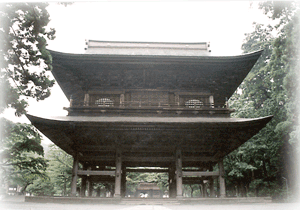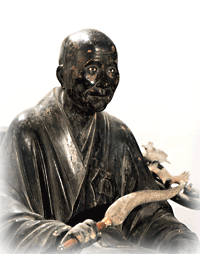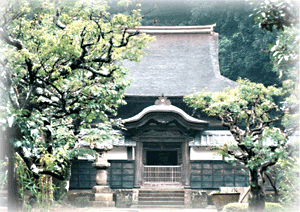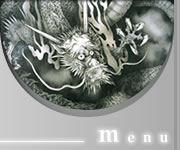
Engaku-ji is number two of the Kamakura Five Mountain Zen temples, and the
head of the Engaku-ji branch of Rinzai Zen Buddhism. It was founded in 1282
by the eighth Kamakura regent Hojo Tokimune 北条時宗 (1251–1284), who wished
both to spread the Zen teachings and to bring peace to the spirits of all
those, both Japanese and Mongol, who had perished during the Mongol
invasions of 1274 and 1281. Tokimune invited his Zen teacher, the Chinese
priest Wuxue Zuyuan 無學祖元 (J., Mugaku Sogen; 1226–1286), to serve as the
first abbot. It is said that the temple was named Engaku-ji, “Temple of
Perfect Enlightenment,” because a copy of the
Sutra of Perfect Enlightenment
圓覺經 was unearthed during construction. The mountain name, Zuirokuzan,
“Auspicious Deer Mountain,” derives from the legend that at the time of the
opening ceremony for the Buddha Hall a herd of deer came to listen to Wuxue
Zuyuan’s sermon.
 Wuxue was suceeded by his disciple Koho Ken’nichi 高峰
顕日 (1241–1316), and Koho
by his disciple Muso Soseki 無窓疎石(1275-1351). The temple flourished as a center of Gozan
literature and Muromachi culture during the fourteenth and fifteenth
centuries. Although It has suffered earthquake damage and destruction by fire on a
number of occasions, support by the imperial court and the shogunate
have enabled it to rebuild on each occasion. During the Edo period there was
a time of decline, but the master Seisetsu Shucho 誠拙周樗 (1745–1820) restored
the temple's important buildings and revived its Zen training, laying the foundations
of Engaku-ji as it is today.
Wuxue was suceeded by his disciple Koho Ken’nichi 高峰
顕日 (1241–1316), and Koho
by his disciple Muso Soseki 無窓疎石(1275-1351). The temple flourished as a center of Gozan
literature and Muromachi culture during the fourteenth and fifteenth
centuries. Although It has suffered earthquake damage and destruction by fire on a
number of occasions, support by the imperial court and the shogunate
have enabled it to rebuild on each occasion. During the Edo period there was
a time of decline, but the master Seisetsu Shucho 誠拙周樗 (1745–1820) restored
the temple's important buildings and revived its Zen training, laying the foundations
of Engaku-ji as it is today.
 Engaku-ji in modern times has been blessed with
a succession of eminent masters, notably Imakita Kosen 今北洪川 (1816‐1892) and
Shaku Soen 釋宗演 (1859–1919). Owing to their efforts and those of their
successors, the temple has remained active in teaching Zen to both ordained
and lay practicers. The temple maintains the classical Chinese Zen monastic
design, with a Sanmon (Mountain Gate), Butsuden (Buddha Hall), Hojo (Abbot’s
Quarters), Yokushitsu (Bath House), Tosu seki (Toilet foundations), and Sodo
(Meditation Hall). Of the seven classical monastic buildings it lacks only
the Hatto (Dharma Hall) and Kyozo (Sutra Library).
Engaku-ji in modern times has been blessed with
a succession of eminent masters, notably Imakita Kosen 今北洪川 (1816‐1892) and
Shaku Soen 釋宗演 (1859–1919). Owing to their efforts and those of their
successors, the temple has remained active in teaching Zen to both ordained
and lay practicers. The temple maintains the classical Chinese Zen monastic
design, with a Sanmon (Mountain Gate), Butsuden (Buddha Hall), Hojo (Abbot’s
Quarters), Yokushitsu (Bath House), Tosu seki (Toilet foundations), and Sodo
(Meditation Hall). Of the seven classical monastic buildings it lacks only
the Hatto (Dharma Hall) and Kyozo (Sutra Library).
Engaku-ji’s bronze temple bell, a National Treasure, was cast in 1301. It is
the largest bell in Kamakura, measuring 2.6 meters in height and 1.42 meters
in diameter. The Shariden (Reliquary), first built in 1285 and restored
after a fire in 1563, is also a National Treasure, and is said to contain a
tooth of the Buddha brought from China.


 Engaku-ji is number two of the Kamakura Five Mountain Zen temples, and the
head of the Engaku-ji branch of Rinzai Zen Buddhism. It was founded in 1282
by the eighth Kamakura regent Hojo Tokimune 北条時宗 (1251–1284), who wished
both to spread the Zen teachings and to bring peace to the spirits of all
those, both Japanese and Mongol, who had perished during the Mongol
invasions of 1274 and 1281. Tokimune invited his Zen teacher, the Chinese
priest Wuxue Zuyuan 無學祖元 (J., Mugaku Sogen; 1226–1286), to serve as the
first abbot. It is said that the temple was named Engaku-ji, “Temple of
Perfect Enlightenment,” because a copy of the Sutra of Perfect Enlightenment
圓覺經 was unearthed during construction. The mountain name, Zuirokuzan,
“Auspicious Deer Mountain,” derives from the legend that at the time of the
opening ceremony for the Buddha Hall a herd of deer came to listen to Wuxue
Zuyuan’s sermon.
Engaku-ji is number two of the Kamakura Five Mountain Zen temples, and the
head of the Engaku-ji branch of Rinzai Zen Buddhism. It was founded in 1282
by the eighth Kamakura regent Hojo Tokimune 北条時宗 (1251–1284), who wished
both to spread the Zen teachings and to bring peace to the spirits of all
those, both Japanese and Mongol, who had perished during the Mongol
invasions of 1274 and 1281. Tokimune invited his Zen teacher, the Chinese
priest Wuxue Zuyuan 無學祖元 (J., Mugaku Sogen; 1226–1286), to serve as the
first abbot. It is said that the temple was named Engaku-ji, “Temple of
Perfect Enlightenment,” because a copy of the Sutra of Perfect Enlightenment
圓覺經 was unearthed during construction. The mountain name, Zuirokuzan,
“Auspicious Deer Mountain,” derives from the legend that at the time of the
opening ceremony for the Buddha Hall a herd of deer came to listen to Wuxue
Zuyuan’s sermon.
 Wuxue was suceeded by his disciple Koho Ken’nichi 高峰
顕日 (1241–1316), and Koho
by his disciple Muso Soseki 無窓疎石(1275-1351). The temple flourished as a center of Gozan
literature and Muromachi culture during the fourteenth and fifteenth
centuries. Although It has suffered earthquake damage and destruction by fire on a
number of occasions, support by the imperial court and the shogunate
have enabled it to rebuild on each occasion. During the Edo period there was
a time of decline, but the master Seisetsu Shucho 誠拙周樗 (1745–1820) restored
the temple's important buildings and revived its Zen training, laying the foundations
of Engaku-ji as it is today.
Wuxue was suceeded by his disciple Koho Ken’nichi 高峰
顕日 (1241–1316), and Koho
by his disciple Muso Soseki 無窓疎石(1275-1351). The temple flourished as a center of Gozan
literature and Muromachi culture during the fourteenth and fifteenth
centuries. Although It has suffered earthquake damage and destruction by fire on a
number of occasions, support by the imperial court and the shogunate
have enabled it to rebuild on each occasion. During the Edo period there was
a time of decline, but the master Seisetsu Shucho 誠拙周樗 (1745–1820) restored
the temple's important buildings and revived its Zen training, laying the foundations
of Engaku-ji as it is today. Engaku-ji in modern times has been blessed with
a succession of eminent masters, notably Imakita Kosen 今北洪川 (1816‐1892) and
Shaku Soen 釋宗演 (1859–1919). Owing to their efforts and those of their
successors, the temple has remained active in teaching Zen to both ordained
and lay practicers. The temple maintains the classical Chinese Zen monastic
design, with a Sanmon (Mountain Gate), Butsuden (Buddha Hall), Hojo (Abbot’s
Quarters), Yokushitsu (Bath House), Tosu seki (Toilet foundations), and Sodo
(Meditation Hall). Of the seven classical monastic buildings it lacks only
the Hatto (Dharma Hall) and Kyozo (Sutra Library).
Engaku-ji in modern times has been blessed with
a succession of eminent masters, notably Imakita Kosen 今北洪川 (1816‐1892) and
Shaku Soen 釋宗演 (1859–1919). Owing to their efforts and those of their
successors, the temple has remained active in teaching Zen to both ordained
and lay practicers. The temple maintains the classical Chinese Zen monastic
design, with a Sanmon (Mountain Gate), Butsuden (Buddha Hall), Hojo (Abbot’s
Quarters), Yokushitsu (Bath House), Tosu seki (Toilet foundations), and Sodo
(Meditation Hall). Of the seven classical monastic buildings it lacks only
the Hatto (Dharma Hall) and Kyozo (Sutra Library).